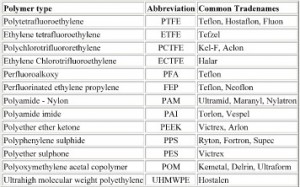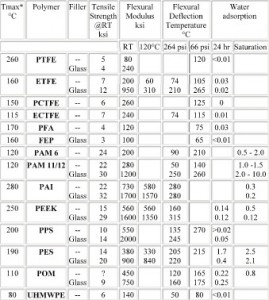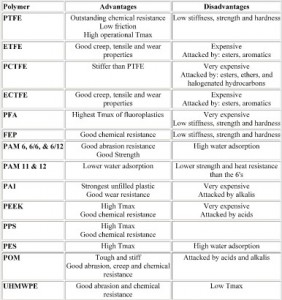A large number of thermoplastic materials are offered in valves, mainly as soft-seat options for ball valve applications. Also lined valves like, lined butterlfy valve, lined globe valve, lined check valve. For this reason, the following section outlines some of the fundamental aspects of the properties, capabilities and application of these materials.
Material types
Mechanical properties
Chemical resistance
Material types
Table 1 shows the polymer types, used in valve applications, together with common abbreviations and Tradenames for the materials mentioned in these Guidelines.
Table 1 Soft seat thermoplastic materials
Polymer type Abbreviation Common Tradenames
Polytetrafluoroethylene ,PTFE Teflon, Hostaflon, Fluon
Ethylene tetrafluoroethylene, ETFE Tefzel
Polychlorotrifluororethylene, PCTFE Kel-F, Aclon
Ethylene Chlorotrifluoroethylene, ECTFE Halar
Perfluoroalkoxy, PFA Teflon
Perfluorinated ethylene propylene, FEP Teflon, Neoflon
Polyamide – Nylon PAM Ultramid, Maranyl, Nylatron
Polyamide imide, PAI Torlon, Vespel
Polyether ether ketone, PEEK Victrex, Arlon
Polyphenylene sulphide, PPS Ryton, Fortron, Supec
Polyether sulphone, PES, Victrex
Polyoxymethylene acetal copolymer, POM Kemetal, Delrin, Ultraform
Ultrahigh molecular weight polyethylene, UHMWPE, Hostalen
In general, these materials can be divided into a number of generic groupings: Fluoropolymers – Polymers such as PTFE, PCTFE, ECTFE etc are based on fluorinated hydrocarbon chain polymers, derived mainly from tetrafluoroethylene and various chloro- derivatives.
Phenol derived polymers – Linear polymers such as PEEK, PES, and PPS incorporate phenylene groups, together with oxygen, sulphur and carbon.
Polyamides – Polymers, such as the nylons and PAI, incorporate the -NH-(C=O)- group. Polyolefins – Hydrocarbon chain polymers, such as polyethylene and polypropylene.
Mechanical properties
The thermoplastic materials differ fundamentally from elastomers in that they have much reduced elastic capabilities, and undergo permanent deformation when subjected to strains of more than 5 to 10% or so (c.f. the elongation of rubbers, which may be between 70 & 700%).
The mechanical properties of these materials vary considerably, and their successful application depends on appropriate materials selection. In essence, the level of mechanical properties of a material govern the pressure at which that material can be successfully employed. As strength properties invariably fall off with temperature, the pressure rating of a soft seat material in a valve application will also be reduced as the temperature increases.
In order to extend the pressure capabilities of thermoplastics at elevated temperature, they are often blended with reinforcing fillers such as glass or carbon fibre, to improve strength and stiffness. Other fillers, such as graphite, MoS2 or PTFE, may be added in order to reduce friction, and control valve torque.
Table 2 shows typical mechanical properties of virgin and filled thermoplastic polymers, used as valve soft seats.
Table 2 Mechanical properties of thermoplastic valve seat materials
Chemical resistance
The thermoplastic materials generally show excellent chemical resistance. There is, however, a balance between the degree of chemical inertness and mechanical properties – one can be improved at the expense of the other, e.g. PTFE is clearly the most chemically inert of all, but has rather inferior mechanical properties.
There are a number of other points to note. Whilst the fluorocarbon materials have very low water absorption, several of the other materials, in particular the nylons, absorb rather large amounts of moisture. There are also certain chemical types which attack certain materials: acids affect PEEK and POM; aromatics affect ECTFE; ethers and esters affect ECTFE and PCTFE; alkalis affect PAI and POM.
Table 3 is a summary of the outstanding features of each of the thermoplastic materials used as soft seats.
Polymer Advantages Disadvantages
PTFE Outstanding chemical resistance Low friction High operational Tmax Low stiffness, strength and hardness
ETFE Good creep, tensile and wear properties Expensive Attacked by: esters, aromatics
PCTFE Stiffer than PTFE Very expensive Attacked by: esters, ethers, and halogenated hydrocarbons
ECTFE Good creep, tensile and wear properties Expensive Attacked by: esters, aromatics
PFA Highest Tmax of fluoroplastics Very expensive Low stiffness, strength and hardness
FEP Good chemical resistance Low stiffness, strength and hardness
PAM 6, 6/6, & 6/12 Good abrasion resistance Good Strength High water adsorption
PAM 11 & 12 Lower water adsorption Lower strength and heat resistance than the 6’s PAI Strongest unfilled plastic Good wear resistance Very expensive Attacked by alkalis
PEEK High Tmax Good chemical resistance Very expensive Attacked by acids
PPS High Tmax Good chemical resistance
PES High Tmax High water adsorption
POM Tough and stiff Good abrasion, creep and chemical resistance Attacked by acids and alkalis
UHMWPE Good abrasion and chemical resistance Low Tma


